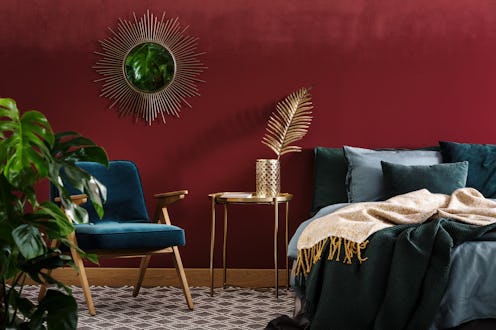(Living)
How To Use The Feng Shui Bagua Map In Your Bedroom

Redecorating your home isn't always just about moving pieces around at random. Sure, aesthetics are always important, but if you subscribe to the philosophy that the way you design your space can dictate its energy, there's a lot more that goes into the process than Pinterest inspiration. According to the ancient Chinese practice of feng shui (particularly in relation to the bagua energy map), the choices you make as you design your interior can bring love, luck, wealth, and more forms of positivity into your life — and what better place to get the good energy flowing than your bedroom?
Practitioner Meghan Wallace James takes an admittedly more modern approach to feng shui as she works to harmonize the spaces of her private clients around the country and beyond, and she notes that a major component of creating this effect in your bedroom is with the use of color. The practice places a lot of importance on color, which can differ from person to person depending on factors like the layout of your space or what you're looking to achieve. "I partner with clients to design bedrooms that are opulently empty yet engaging and purposeful," she shares. "Color plays a vital role, for paint — a new beginning in a can — is transformative to the ambient mood."
James, who is launching both an e-course and monthly membership call in the new year, can attribute much of her success to her user-friendly, intuitive take on feng shui. Her methods can help guide those who are in the market for a bedroom boost via a fresh coat of paint, but aren't sure how to choose. Ahead, find her feng-shui-by-way-of-bagua tips for finding the perfect hue that just might change your life.
Know Your Bagua Basics
There are quite a few feng shui styles, but James sticks to a Westernized one that bases much of the design decisions on the placement of your front door. She uses the bagua, a classic feng shui energy map (see above), to help clients do exactly that — and that includes choosing colors and materials. "In my private practice, I orient the bagua based upon a dwelling’s front door, and most typically overlay it upon the floor plan," she explains. "[The chart] contains nine zones, or guas, each with their own name, material element correlation, and recommended color palette." Using your front door as a starting point, you can find your bedroom on the bagua and learn what colors and materials might work best for you.
Consider Your Qi
Using the bagua as your guide, you can learn a lot about the qi, or energy of the room. "In the bagua, certain guas — creativity, attraction, life path, and wisdom — are cooler in temperament, and cool, crisp colors like blacks, blues, whites, metallics just feel right living there," James says. "Other guas — legacy, love, and health — are warmer and vibrate beautifully with fiery shades of a sunset like reds, pinks, oranges, and yellows." Alternatively, if your bedroom falls into the family or abundance areas, she suggests wood tones, like greens and browns.
Ask Yourself What You Want From Your Space
"Whichever gua your bedroom rests within, my modality views it as a hub for both love and abundance," explains James, who is a big believer that bedrooms should be used solely for two purposes: rest and sexuality. According to her, those looking for more love and abundance — who isn't? — should ask themselves a few specific questions to help guide them to an ideal bedroom color. Some that she suggests include: Is this color sensual? Does this color elevate my bedroom furnishings and create an atmosphere of wealth and purpose? Does this color make me feel secure and safe to dream big?
Use Your Intuition
"Modern feng shui is ripe with metaphors, yet they may take time to reveal themselves," James says. "Let your color choice be ephemeral, and if there is a deeper meaning behind it, trust me, it shall be revealed." This one is as easy is it sounds: Give value to some design choices that just pop up organically and intuitively.
Balance Yin And Yang
In terms of feng shui, yin and yang are the opposing masculine and feminine forces. "Factor this into the color you choose by playing into the tension in a delightful way," suggests James, who adds that this is an especially important consideration for those sharing the space with a partner. Use the bagua as a tool to help you pick out a color outside the traditional gendered boxes. A perfect example is the Portola paint shade she recently selected for her own room. "My bedroom is currently a dark moody green called Inspiration," she explains. "It makes me feel sexy yet regal; dreamy yet on my path. And the name is certainly lovely!"